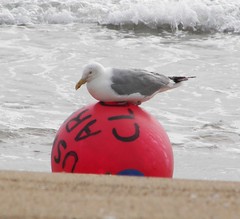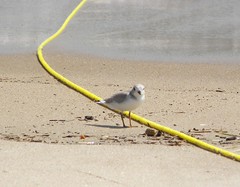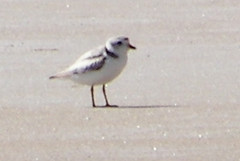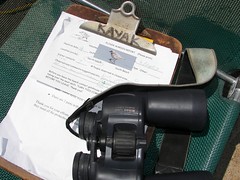Lately the media has been noticing piping plovers. Here's a roundup:
Late nesters on Cape Cod. With storms and the subsequent changes to the beaches, the Cape Cod plovers haven't all been having a banner year.
Check out the video of the Crane's Beach piping plovers on the TV news. The day after this was on the channel 5 news, folks at Gray Cubicle World kept coming up to me telling me "hey, those birds you guard were on the news last night" and so on.
Hampton Beach even had a nest hatch this year. Meant to post this earlier. There is a very cute chick photo.
Life on the beach at Parker River National Wildlife Refuge and occasional other birding adventures and, of course, piping plovers.
Friday, July 27, 2007
Saturday, July 21, 2007
Herring Gull on Float
It took me a long time to figure out what's wrong with this gull. It's got a fish hook, some fishing line, and a sinker stuck on/in its bill. When it flew off I could see the line and the sinker hanging down from it. The poor gull was miserable. It kept trying to flip the line and sinker up into its mouth and swallow it. I didn't see it again after it flew away. I hope it gets the hook out somehow.
There's not much bird action or visitor action this morning. The usual gull suspects, a small flock of sanderlings, a lone piping plover, and some tree swallows are just about it. The piping plover was hanging around with a pair of sanderlings for some time, feeding along the water line. Then one of the sanderlings got too close and the plover attacked it. The piping plover charged it like a bulldog with much fluttering of wings and pecking. They are very aggressive and bossy when not using their cloak of invisibility as their primary defense mechanism. The two sanderlings flew down the beach to join a flock of about half a dozen of their own kind. The piping plover kept on feeding alone for an hour or more until it flew off somewhere.
A couple of ring-billed gulls were feeding along the water line as well, probing like sanderlings. Ring-billed gulls have a very flexible feeding strategy -- catch flies, catch fish, dig huge marine worms out of their holes in the sand, you name it. Actually one of the gulls did pull a big worm out of a hole in the sand right in front of me. The other gull got a much smaller worm from a nearby hole. More impressive gull behavior.
A vintage biplane flew over a couple of times. Its engine sounded loud and deeply retro mechanical. Lots of other small planes, some old, some new, also flew over but the only engine nearly as loud as the biplane was the tour boat out of Newburyport harbor. The boat went back and forth several times as well as anchoring for awhile. Definitely not whale watching as they were far too close to shore. It looked like some people had fishing rods. Must've been a fishing trip. Anyway, it was louder than all the planes and stayed around longer.
It's not every day I get to see a piping plover AND a vintage biplane as I'm drinking my morning coffee. Plover wardening has its rewards.
Coffee of the day: Ethiopian Harrar. Oh, and I forgot to post last Saturday's coffee of the day. It was Brazilian Cerado for those keeping track.
There's not much bird action or visitor action this morning. The usual gull suspects, a small flock of sanderlings, a lone piping plover, and some tree swallows are just about it. The piping plover was hanging around with a pair of sanderlings for some time, feeding along the water line. Then one of the sanderlings got too close and the plover attacked it. The piping plover charged it like a bulldog with much fluttering of wings and pecking. They are very aggressive and bossy when not using their cloak of invisibility as their primary defense mechanism. The two sanderlings flew down the beach to join a flock of about half a dozen of their own kind. The piping plover kept on feeding alone for an hour or more until it flew off somewhere.
A couple of ring-billed gulls were feeding along the water line as well, probing like sanderlings. Ring-billed gulls have a very flexible feeding strategy -- catch flies, catch fish, dig huge marine worms out of their holes in the sand, you name it. Actually one of the gulls did pull a big worm out of a hole in the sand right in front of me. The other gull got a much smaller worm from a nearby hole. More impressive gull behavior.
A vintage biplane flew over a couple of times. Its engine sounded loud and deeply retro mechanical. Lots of other small planes, some old, some new, also flew over but the only engine nearly as loud as the biplane was the tour boat out of Newburyport harbor. The boat went back and forth several times as well as anchoring for awhile. Definitely not whale watching as they were far too close to shore. It looked like some people had fishing rods. Must've been a fishing trip. Anyway, it was louder than all the planes and stayed around longer.
It's not every day I get to see a piping plover AND a vintage biplane as I'm drinking my morning coffee. Plover wardening has its rewards.
Coffee of the day: Ethiopian Harrar. Oh, and I forgot to post last Saturday's coffee of the day. It was Brazilian Cerado for those keeping track.
Friday, July 20, 2007
boundary moved to lot 6
Belated entry for July 14 (been a heckuva busy week).
The boundary moved to Lot 6. Gatehouse told me that Frank and the refuge manager had moved the buoys and rope to the new boundary but he didn't know if they had actually set it up. I drove down there expecting that I might have to run the rope and buoys down to the water but everything was in place when I got there.
It was an easy day. If I'd had one less visitor or one more piping plover things would have been equal. Four visitors and three piping plovers. One of said plovers is pictured here. Note the lack of head stripe, incomplete neck ring, and abundance of white on this guy. A first year bird. So what do you suppose it thinks is on the other side of that rope? Eventually all three piping plovers converge on the open area of beach and fly off together calling peep-lo. What a treat.
The boundary moved to Lot 6. Gatehouse told me that Frank and the refuge manager had moved the buoys and rope to the new boundary but he didn't know if they had actually set it up. I drove down there expecting that I might have to run the rope and buoys down to the water but everything was in place when I got there.
It was an easy day. If I'd had one less visitor or one more piping plover things would have been equal. Four visitors and three piping plovers. One of said plovers is pictured here. Note the lack of head stripe, incomplete neck ring, and abundance of white on this guy. A first year bird. So what do you suppose it thinks is on the other side of that rope? Eventually all three piping plovers converge on the open area of beach and fly off together calling peep-lo. What a treat.
Sunday, July 8, 2007
article
Here's the Boston Globe article about plover wardening.I didn't get a chance to talk to this guy from the Globe because of the emergency trip to Manchester (aka weekend from hell) on account of Nancy's Dad, so I told him he could use anything I wrote in the blog. Fortunately, I only get one or two visitors a year who threaten to eat them.
As usual, Unit 3 gives good sound bite.
As usual, Unit 3 gives good sound bite.
Thursday, July 5, 2007
human signpost
Tuesday was a glorious beach day -- plenty of sun, cool breeze, not too crowded. Despite the fact that there were lots of visitors on the beach I only spoke with two people. I mostly functioned as a human signpost. Joggers along the water line would look up, see me, and turn around. Parents would point at the sign then at me and get their kids to turn around. Hmm, is a plover warden symbolic fencing? :-) Actually, it seemed like I was acting as evidence that "they really mean it" -- not only are there signs and rope but a real person to enforce it.
Bird action was very quiet. The four usual gull species hung out on the sand: Bonaparte's, ringbilled, herring, and great black back. A few cormorants bobbed on the waves, diving intermittently. A seal swam by. I got my first greenhead bite of the season but was not otherwise plagued by the winged jaws of July.
Gatehouse Donald says the three remaining active nests should hatch soon. I did not see any chicks or adults on Tuesday. Although the nests are closer to the north boundary, I tend to see more piping plovers at the south. The nests, including the least tern colony, are concentrated in the general vicinity of lots 2 and 3.
As you can see from the photo, my list of bird sightings for the day was very short. I am next scheduled for the 14th.
Bird action was very quiet. The four usual gull species hung out on the sand: Bonaparte's, ringbilled, herring, and great black back. A few cormorants bobbed on the waves, diving intermittently. A seal swam by. I got my first greenhead bite of the season but was not otherwise plagued by the winged jaws of July.
Gatehouse Donald says the three remaining active nests should hatch soon. I did not see any chicks or adults on Tuesday. Although the nests are closer to the north boundary, I tend to see more piping plovers at the south. The nests, including the least tern colony, are concentrated in the general vicinity of lots 2 and 3.
As you can see from the photo, my list of bird sightings for the day was very short. I am next scheduled for the 14th.
Monday, July 2, 2007
the shell seekers
Observe the invisibird being invisible. I took this about 9:30 this morning before the beach filled up with visitors. It hung around for awhile and then took off calling peep-lo as soon as the first group of shell seekers arrived. Everybody's looking for shells today. They remind me of the fictional painting in that tear jerker of a Hallmark Hall of Fame movie based on the novel by Rosamunde Pilcher.
The shell seekers carried bags and buckets and walked along the shore looking down, hence failing to see the signs or me so I spent a lot of time shepherding them out of the closed area or intercepting them before they got there. Different people seemed to have different goals in their shell seeking, but sand dollars seemed to be the most popular. One woman said she'd never found one before and it made her day. A couple from Vermont, a family with a bunch of kids, a toddler who babbled delightedly in long totally incomprehensible sentences (at least I think they were sentences and they seemed to be addressed to me), and the usual lone walkers all seemed to be finding what they were looking for.
The bird action was pretty slow. A pair of the scruffiest white winged scoters I've ever seen floated for hours just off Emerson Rocks. A couple of Bonaparte's gulls flew by. Ring billed gulls and herring gulls mostly sat in the sand. Every once in awhile one of the herring gulls would attack one of the ringbills and drive it to a different spot on the beach. None of them appeared to have any prey to be arguing over. I think they just needed space. A mockingbird sang from the top of the 5.9 mile marker. A small flock of tree swallows caught flies in the wrack. All the usual beach stuff of a usual early July day unfolded.
The crew came to move the fencing and signs so they could reopen Lot 7. They dug up the big sign and the real fencing but left the rope and buoys for another team to move later. I packed up my stuff and walked back to the car to drive to Lot 7 even so I could free up a space in the Sandy Point lot by using the official plover warden parking spot. It's not that long a walk from where I was to the new boundary but moving the car saved me a long walk back at the end of the shift.
As soon as the Lot 7 beach opened, the shell seekers extended their foraging.
The shell seekers carried bags and buckets and walked along the shore looking down, hence failing to see the signs or me so I spent a lot of time shepherding them out of the closed area or intercepting them before they got there. Different people seemed to have different goals in their shell seeking, but sand dollars seemed to be the most popular. One woman said she'd never found one before and it made her day. A couple from Vermont, a family with a bunch of kids, a toddler who babbled delightedly in long totally incomprehensible sentences (at least I think they were sentences and they seemed to be addressed to me), and the usual lone walkers all seemed to be finding what they were looking for.
The bird action was pretty slow. A pair of the scruffiest white winged scoters I've ever seen floated for hours just off Emerson Rocks. A couple of Bonaparte's gulls flew by. Ring billed gulls and herring gulls mostly sat in the sand. Every once in awhile one of the herring gulls would attack one of the ringbills and drive it to a different spot on the beach. None of them appeared to have any prey to be arguing over. I think they just needed space. A mockingbird sang from the top of the 5.9 mile marker. A small flock of tree swallows caught flies in the wrack. All the usual beach stuff of a usual early July day unfolded.
The crew came to move the fencing and signs so they could reopen Lot 7. They dug up the big sign and the real fencing but left the rope and buoys for another team to move later. I packed up my stuff and walked back to the car to drive to Lot 7 even so I could free up a space in the Sandy Point lot by using the official plover warden parking spot. It's not that long a walk from where I was to the new boundary but moving the car saved me a long walk back at the end of the shift.
As soon as the Lot 7 beach opened, the shell seekers extended their foraging.
Sunday, July 1, 2007
amazing purple martin tricks
This is not a kayak. Just clearing up any possible confusion before proceeding to any actual content of this entry. That is a Moo mini card of a piping plover on top of the report form on the clipboard that is not a kayak.
So, yes, I made it to the beach on Saturday for my shift. I saw no piping plovers but Unit 61 updated me as best he could: two active nests with chicks on the refuge beach plus three more nests that haven't hatched yet and he's seen one or two chicks running around at Sandy Point. The interesting thing about the late nests that have yet to hatch is that they are near or within the least tern colony. This is good news because the least terns are much more aggressive (and talented) at repelling avian predators. They get together as a colony and dive bomb the alien invader and poop on him. Piping plovers rely more on the broken wing display or sometimes one on one attacks on gulls. Plus the least tern colony has an electric fence that repels those pesky mammalian predators. I imagine that once upon a time when there were way more of both species, their nesting in proximity to each other was an effective strategy.
Although the beach was crowded, I didn't speak with many visitors. Only a few people had the usual question "when will the beach be open?" Nobody asked how the plovers were doing or what a piping plover or least tern is or any of the things I love to talk about. Mostly I talked with one of the guys fishing for stripers about various beach/striper/bird related things. A flock of Bonaparte's gulls started all diving together in one spot, which usually indicates bait fish boiling up out of the water in flight from the stripers, so the fisherman cast accordingly but had no luck. There wasn't a whole lot of other bird activity on the water.
There was however one remarkable bird activity: an amazing purple martin trick. The purple martin flew over the dunes and out over the water. It disappeared into a trough between waves and then made a beeline back out directly over my head carrying a fish in its beak. A purple martin caught a fish! I have never seen that in my life. Neither had striper fishing guy. I guess it's not all that different from catching insects in the air but it certainly amazed me.
After the shift I headed up to Manchester, NH to rendezvous with Nancy and her parents again as her Dad is still in the hospital although no longer in immediate danger of leaving the planet. We drove her Mom back to their place and then by the time we got back to my place we were both totally wiped out. We went back up to Manchester today to take her Mom out to lunch and then to visit her Dad. So now that I'm home I'm catching up on stuff like blogging and email and chores and whatever. I'm taking next week off so I can have some time to myself --- on the beach with the plovers of course. I signed up for shifts on both Monday and Tuesday mornings. Maybe I'll even get to see one of the invisi-birds.
So, yes, I made it to the beach on Saturday for my shift. I saw no piping plovers but Unit 61 updated me as best he could: two active nests with chicks on the refuge beach plus three more nests that haven't hatched yet and he's seen one or two chicks running around at Sandy Point. The interesting thing about the late nests that have yet to hatch is that they are near or within the least tern colony. This is good news because the least terns are much more aggressive (and talented) at repelling avian predators. They get together as a colony and dive bomb the alien invader and poop on him. Piping plovers rely more on the broken wing display or sometimes one on one attacks on gulls. Plus the least tern colony has an electric fence that repels those pesky mammalian predators. I imagine that once upon a time when there were way more of both species, their nesting in proximity to each other was an effective strategy.
Although the beach was crowded, I didn't speak with many visitors. Only a few people had the usual question "when will the beach be open?" Nobody asked how the plovers were doing or what a piping plover or least tern is or any of the things I love to talk about. Mostly I talked with one of the guys fishing for stripers about various beach/striper/bird related things. A flock of Bonaparte's gulls started all diving together in one spot, which usually indicates bait fish boiling up out of the water in flight from the stripers, so the fisherman cast accordingly but had no luck. There wasn't a whole lot of other bird activity on the water.
There was however one remarkable bird activity: an amazing purple martin trick. The purple martin flew over the dunes and out over the water. It disappeared into a trough between waves and then made a beeline back out directly over my head carrying a fish in its beak. A purple martin caught a fish! I have never seen that in my life. Neither had striper fishing guy. I guess it's not all that different from catching insects in the air but it certainly amazed me.
After the shift I headed up to Manchester, NH to rendezvous with Nancy and her parents again as her Dad is still in the hospital although no longer in immediate danger of leaving the planet. We drove her Mom back to their place and then by the time we got back to my place we were both totally wiped out. We went back up to Manchester today to take her Mom out to lunch and then to visit her Dad. So now that I'm home I'm catching up on stuff like blogging and email and chores and whatever. I'm taking next week off so I can have some time to myself --- on the beach with the plovers of course. I signed up for shifts on both Monday and Tuesday mornings. Maybe I'll even get to see one of the invisi-birds.
Subscribe to:
Comments (Atom)




